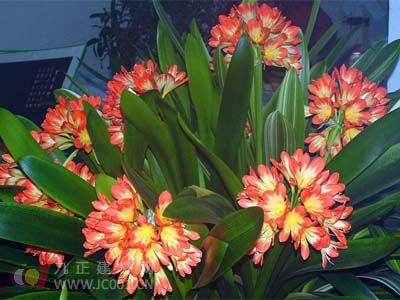Clivia is a cool, moist, semi-negative environment with a suitable temperature of 15 to 25 ° C. If the temperature is higher than 26 to 28 ° C, it will be dormant or semi-dormant. If the temperature is higher, it is easy to cause illness and death.
In the summer, Clivia should be placed indoors or in a ventilated place under the shade. In the surrounding environment, always sprinkle water or place a water basin, and spray water on the leaves to increase air humidity and lower temperature. When spraying water, do not pour water into the center to prevent rotten heart.
Although the watering amount in summer is higher than other seasons, it is necessary to keep it dry and not poured. Also be careful not to wait until the potting soil has dried up before pouring it. When it is half dry, it is necessary to pour it, so that the potting soil is always kept moist.

When the temperature rises above 25 9C, the growth of Clivia is inhibited. At this time, it is necessary to stop fertilization, such as continuing fertilization, easy to rotten roots, rotten stems. If the environmental temperature of Clivia can be lowered to below 25 °C, it is also possible to apply a thin liquid fertilizer of 1:20 or more in the summer, once every half month. This promotes the growth of Jun r Lan, making it shorter or no dormant.
Clivia is a medium-light flower, likes soft light, and avoids exposure to the sun. In summer, it must be placed in a ventilated place under the shade, to avoid direct sunlight in the afternoon. If it is exposed to strong light, it will cause "sunburn", and the leaves will have a large area of ​​brown spots and dryness.
In order to improve the resistance of Clivia to its adverse environment, in the later stage of spring growth, the application of nitrogen fertilizer should be appropriately reduced according to the seedling condition, and the amount of phosphorus and potassium fertilizer should be increased. Starting from March, 1% to 3% potassium dihydrogen phosphate or superphosphate is once per 10 days. In the month before entering the "Meiyu" period, the roots were topdressed 3-4 times with 1% potassium dihydrogen phosphate.
In the rainy season, the humidity is high. If there is no ventilation, and the hot temperature, the resistance of Clivia to some invasive diseases will decrease. It is necessary to carry out drug control in batch planting. Pesticides such as carbendazim and thiophanate can be used interchangeably, and sprayed once every 10 days with a concentration of 0.1%.
In the summer, Clivia can not only produce good flowers, but also consume nutrients, which affects the normal flowering of winter and spring. Therefore, it is necessary to cut off the flowers and arrows in time.
(2) It is more resistant to cold in winter, and it is safe to overwinter when the room temperature is above 0 °C. In the early winter, the room temperature is higher, and most of the Clivia is still growing indoors. At this time, the fertilizer can be continued to be applied, which is good for growing branches and flowers and buds in the future. If the room is equipped with heating equipment, the temperature is above 10 °C, the whole winter can continue to grow; Cinnamon Clivia through 7 days once applied thin fertilizer, but also early flowering.
If the room temperature drops below 10 °C, the fertilization should be suspended, because the Clivia is in the slow growth period or the dormancy period. The multi-fertilization is not only difficult to absorb, but harmful.
After the flower has been opened, if you want to keep the seed, the pedicel should not be trimmed; if you don't want to keep the seed, you should cut it off from the base of the pedicel in time, which can reduce nutrient consumption and promote development.
Carbide Mining Bits,Carbide Plate,Vacuum Brazing Plate
Drilling bits Mining bits,Carbide Inserts Co., Ltd. , http://www.nscarbide.com